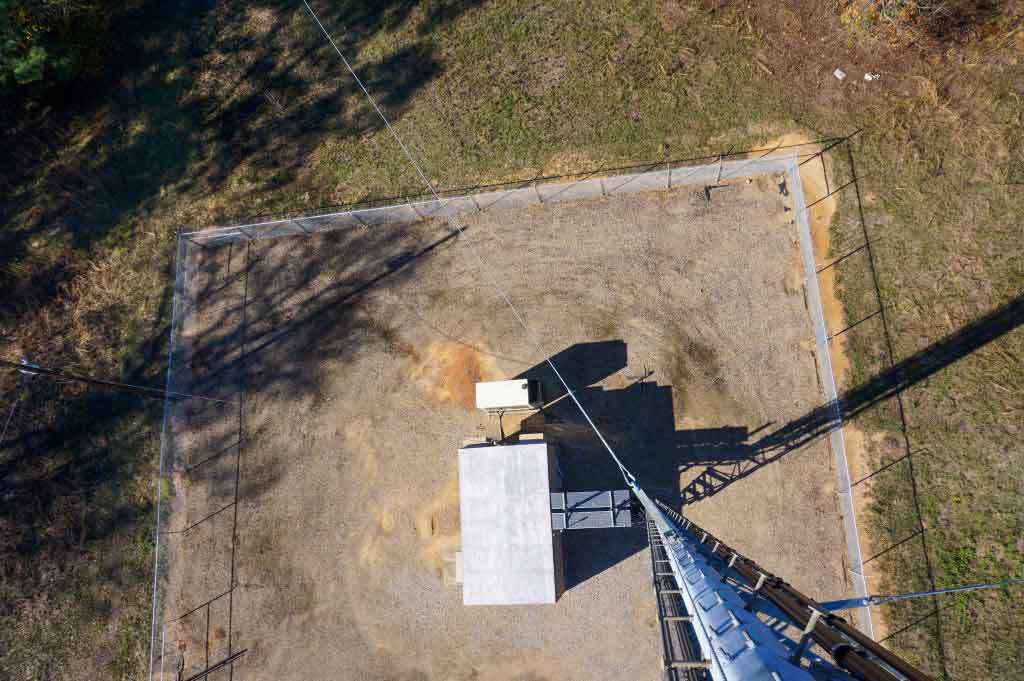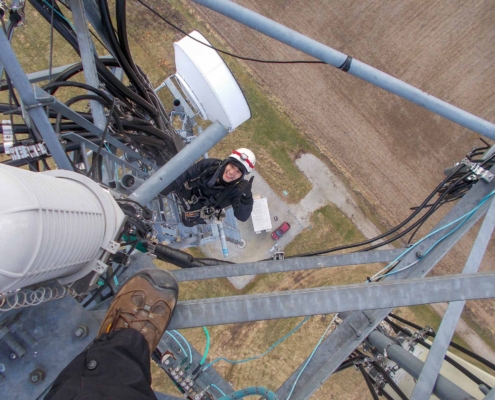Thoughts From a Tower
Welcome to the Thoughts From a Tower series. This series is essentially a combination of stories and ideas. I’ll show some photos and tell stories about the towers and places that I’ve seen. Next, I present interesting thoughts that wandered through my mind while I climbed these towers. Refer to Thoughts From a Tower: Adventurous Mind page for further details.
The best way to deal with your problems is to realize that you are a failure and things will never get better. Quit. Give up. Go home. Cry yourself to sleep.
There it is. I hope that helps—you loser.
I’m just kidding.
While climbing possibly the most dangerous tower in my entire life, I stumbled upon the best way to deal with any problem.
It was quite literally a matter of life and death.
The Metal Death Trap
I had climbed hundreds of towers before. Some were tall. Some were short. Some were complex. Some were simple. Some were easy. Some were a pain to deal with. Some were hot (i.e. broadcast and AM towers). Some were cold (inactive towers). And they all pretty much made my life difficult one way or another.
In other words, they were like the women I dated.
But all towers shared one similar trait—they were relatively safe to climb.
This 400-feet (122-meter) tower was different. I had never encountered such a specimen before. Simply put, this was the kind that killed inexperienced climbers.
Many referred to it as a Metal Death Trap. At the time, I just called it the Pain In My Ass.
These structures are extremely rare and quite ancient (in tower years anyway). Every tall tower like this one is built like a triangular prism—consisting of 3 faces and 3 legs (the corners of the triangle)—and held up by high-strength “Guyed” wires.
Normally, in order to scale modern tall tower, I would climb one of the triangular prism’s faces. However, this tower’s design required climbing on a leg.
While faces were very safe, climbing on the legs of such tall towers posed significant dangers for several reasons:
- The taller the tower, the more “Guyed” wires there were. Since these wires were attached to the tower legs at various elevations, I needed to maneuver around many of them.
- Antennas mounts were mostly placed on legs, so I had to maneuver around very difficult antenna placements as well.
- Most modern towers had rungs (like stepladders) on the faces. Climbing on a tower leg could only be done via hundreds of pegs—small cylindrical metal rods. Even if I fell with safety mechanisms fully in place, the pegs would have scraped my body or broken my bones.
Overall, it was not fun to move like a ninja at such great heights. To quote my climbing partner at the time, “It’s gonna be a shitshow!”
He also said, “If you die, I get your sandwich!”
Nice guy.
A Special Kind of Weird
I lost balance at 80 feet (24 meters) and I slipped several steps before my hands grasped some pegs. Fortunately, it was only a slight slip and not a fall.
“Jesus tap-dancing Christ! Ace, you stupid asshole! Don’t underestimate this shit!” I scolded myself.
The climb was brutally challenging. The tower legs had metal reinforcements—another peculiar design that I had not seen before—so the climbing pegs were separated at uncomfortable distances.
“You’re gonna have to make sure both hands are secure before you start moving your feet,” I told myself. “Moving two quickly might result in one hand and one foot floating.”
After what seemed like an hour, I reached my first problem.
“Shit. You’re gonna have to detach your safety device.” I scanned the obstruction for a minute. The safety wire was pinned by the antenna mount. “Hmm. Tie a lanyard tightly around that peg and hook onto it, then squeeze through that giant cable. Going over it will leave you too extended.”
I twisted and squeezed my body into place. “Hmmm. Relax. Now, wrap your positioning lanyard around that horizontal pipe and pull it tight. Detach your safety device and climb over.”
Hooking my leg on the pipe, I propelled myself upward. “Slow down. Fall and you’ll be stabbed or cut. No one can save you before you bleed out. Or you could plummet to your death. No pressure!”
Without realizing it at first, I had essentially talked myself through the entire experience. I felt safe, in control, and in good hands—even though I was the only person on that tower. It was a surreal experience—and surprisingly therapeutic.
I continued talking myself through 10 more obstructions, calmly guiding my movements as I analyzed the situation.
At last, I found myself below the last obstruction. “Check your elevation marker.”

“380. Tower is 400. Schematics are correct. No one modified the tower height. 20 feet from the top.”
I analyzed the final obstruction. “Ah. Easy. This one is mostly a physical move. Rest for a bit first. You just gotta squeeze between those pipes. Just place your hand over the tip of that pipe—so you don’t scrape yourself.”
And just like that, I was at the top of the tower staring at the lightning rod. “Shitfuck! Forgot the sandwich. The bastard got the sandwich anyway…”
And there you have it. The best way to deal with your problems is to talk yourself through it.
Now you’re probably saying, “Talk myself through it? Talk to myself? Really?! Ace, you freaking weirdo!”
Save your compliments for later. Let me explain.
Communication Is Key
“The best way to deal with your problem is to talk yourself through it.”
When I say that you should talk yourself through it, I don’t mean that you should actually have a conversation with yourself.
You: Hi. How are you?
Also You: I’m good!
You Again: Still crying yourself to sleep?
Still You: Only every other day!
I am simply encouraging the vocalization of thought. In other words, you are literally speaking what’s on your mind. In fact, you have probably seen this before. People often tell themselves to “keep it together.” What I’m recommending is a more complex extension of that process.
By talking yourself through it (i.e. literally speaking your mind), you naturally achieve the following results:
- Distance: You distance yourself from the problem—establishing yourself as the problem-solver instead of as the person with a problem.
- Calmness: You become calmer (or less agitated, at least), putting yourself in the right state of mind.
- Analysis/Evaluation: You begin to analyze/evaluate the problem and gather information, naturally starting the problem-solving process.
- Mitigation: You stop yourself from making the problem worse if you are calm while analyzing the situation.
- Focus: You slow down your frantic thoughts and narrow down what you should be focusing on. You then naturally start planning.
- Plan of Action: You will be able to formulate some sort of plan—no matter how rudimentary—to help solve the problem.
- Guidance: You essentially act as your own personal advisor as you attempt to solve the problem. This allows you to constantly regain focus and continuously strive to solve the problem.
All of these results help you achieve one very important goal: Regaining control of the situation and the problem.
Over time, as you sharpen this skill, you can simply follow the process in your mind. The vocalization of thoughts is just the basic step to get you started on the right track.
By learning to give a voice to your thoughts, you become a much better problem-solver. I still talk myself through my problems regularly. Vocalizing one’s thoughts provides much more clarity. Most of the time, it feels nice to hear things out and talk it through.
No Stakes No Stress
Do you notice that, even though many people are quite bad at solving their own problems, they are amazing at solving the problems of others?
The reason is simple: Most of the time, when you are solving someone else’s problems, you have very little at stake. It is their problem, not yours. This ties back to number 1 from the section above—Distance.
When you have little at stake, there is some distance between you and the problem. You are the problem-solver while others are people with problems.
This can be further explained with a hypothetical scenario.
Imagine yourself relaxing on a beach. While licking your ice cream cone and basking in the sun’s rays, you notice some people swimming in the distance. Suddenly, you see a huge fin slicing through the water, accelerating toward the blissfully unaware swimmers.
You lick your ice cream. “OH, SHIT! You people better get the hell out! There’s a shark in the water!”
All hell breaks loose—in the water. Meanwhile, onshore, you shout out ways to deal with this new problem. “Hey! Swim toward the boats! And push the slower people toward the shark!”
You notice the swimmers losing their minds and frantically darting in all directions.
“Huh…I wonder why they’re not thinking clearly,” you say, casually waving the nearby authorities over.
Once everything is resolved, you walk over to the nearest shop and ask, “Well, that was a shitshow! Glad I was so calm and helped fix it! Hey, you got any more of that ice cream?”
To put it another way, it is much easier to be the “hey, cut that shit out” person than the “hold my beer” person. Because trying to rationally stop a fight is much easier than trying to stop yourself from fighting.
The person with more distance from the problem becomes a much better problem-solver.
There are many advantages when you attempt to distance yourself from the problem:
- It is very easy to remain positive and calm. This ties back to number 2—Calmness.
- You might be able to see the big picture. Sometimes, you will see the solution right away. This ties back to number 3—Analysis/Evaluation.
- Your emotions are under control and are incapable of overwhelming you. And, even if the problem affects you in some way, the magnitude is significantly less, thereby still allowing you to easily collect your thoughts and rethink your problem-solving strategy.
- You reap all the rewards but face minimal risks. It’s like encouraging a friend to “follow their heart” and ask someone out on a date. If they succeed, then you can say, “See?! I told you! Aren’t I a great friend?” If your friend gets rejected, you do not feel the sting of rejection and can say, “Meh. Better luck next time!”
In a way, by talking yourself through your problems, you somewhat distance yourself from your own problems. And if you distance yourself from your problems by even a slight margin, you gain the aforementioned benefits—albeit to a lesser degree. It is a psychological strategy. You are, in a way, hacking your own mind and regaining control.
The Best Personal Advisor
 Life can be hard sometimes. To make matters worse, some of us might not have anyone to make things easier. In that case, you will have to depend on yourself.
Life can be hard sometimes. To make matters worse, some of us might not have anyone to make things easier. In that case, you will have to depend on yourself.
By talking yourself through your own problems, you effectively become your best personal advisor. Because, no matter who comes and goes in your life, you will always have yourself. Even if you do not believe that you are mentally equipped for the task, the persistent effort will pay off.
Remember, you do not have to solve the problem right away. You just have to deal with it first—one step at a time.
In my life, I have successfully dealt with many problems this way. Most importantly, on that day, talking myself through my problems allowed me to easily conquer the Metal Death Trap.
You need not even remember all the numbered benefits. Just remember one task: talk yourself through your problems—preferably by vocalizing your thoughts. That’s it. Everything else will eventually follow.
I know this strategy works beautifully. In fact, I bet my life on it, and it worked better than I could have ever imagined.








 © Copyright - Ace Adventurer
© Copyright - Ace Adventurer © Copyright - Ace Adventurer
© Copyright - Ace Adventurer © Copyright - Ace Adventurer
© Copyright - Ace Adventurer © Copyright - Ace Adventurer
© Copyright - Ace Adventurer © Copyright - Ace Adventurer
© Copyright - Ace Adventurer © Copyright - Ace Adventurer
© Copyright - Ace Adventurer
Great article, Ace. The story was riveting and the message was very clear. It is very relevant to my life right now. Write more “Thoughts From a Tower” articles. I really like reading these.